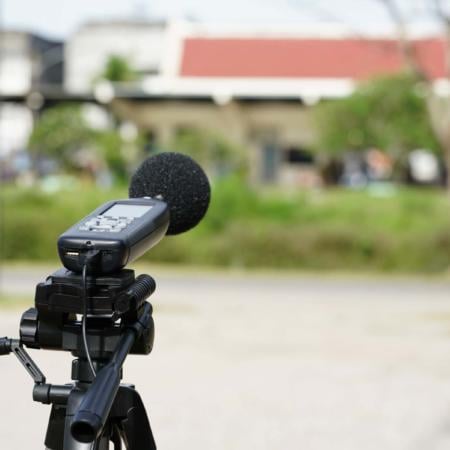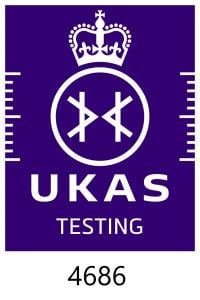
Proudly offering nationwide surveys and shipping for the UK
Call: 01473 396 332 Email: [email protected]
Request a call backEstablished since 2004, we are a leading UK acoustic consultancy based in Ipswich, Suffolk, providing acoustic services nationwide. We are UKAS Accredited (4686) for sound insulation testing which is the preferred accreditation for Building Regulations. Being UKAS accredited demonstrates an ISO 17025 quality management system. Therefore, our reports are guaranteed to be accepted by all Building Control bodies. Our accreditation covers residential dwellings as well as commercial and other buildings.
Our engineers have years of experience and have completed thousands of sound tests. They are members of the Institute of Acoustics and are kept up to date with all new techniques and changes within the industry. So, when choosing us you can be rest assured that you’ll be in safe hands and will receive a high-quality service.

Sound insulation testing has many names. These include, sound testing, soundproof testing, pre-completion testing and so on. This can be very confusing when you are new to this procedure. However, they all mean the same thing, sound insulation testing. Below we explain what this is, when it is required and how to prepare for a test.
Building Regulations Approved Document E (ADE 2003, as amended) applies to new or converted dwellings, flats or rooms-for-residential use. Tests are performed on finished wall and /floors structures. This is the normal route to show compliance of how “soundproof” a building is.
Sound testing considers:
The test results must meet or exceed minimum performance standards. These are shown in the FAQ section below.
Before we attend, it is vital that the rooms requiring testing are properly prepared. As the state of the building can have a substantial impact on the results. See our ‘How to Prepare for A Sound Test’ guidance in the below FAQ section.
When testing separating walls or floors, an airborne test is performed. We do this by placing a loudspeaker in the source room which produces a very high sound level. A level difference is recorded in the receiving room; either directly adjacent, above or below. This level difference is standardised to a reference value. The airborne result is a single number that can be compared to a performance standard.
For testing floors, an impact test is performed. During an impact test we use a standard tapping machine placed on the floor upper room. We then measure the sound pressure level in the receiver room which is directly below. This impact pressure level is standardised to a reference value. The impact result is a single number that can be compared to a performance standard.
See our FAQ section for a full explanation of airborne and impact tests. Performance standards and how many rooms you will need testing.
We frequently provide sound tests for other building types. These include commercial areas, for schools, offices, factories, healthcare buildings and other premises. If you need more information, please contact the team for further advice.
Sound testing is often offered for managing agents of buildings. These tests are outside of the Building Regulations. Usually concentrating on pre- and post-works testing to evaluate floor finish performances. Note that floor finishes are not normally considered in testing floors under a Building Regulations sound test.
Enhanced sound insulation performance standards can apply in commercial units. Where a residential room is separated from another room of non-residential use (e.g. commercial office, bar or shop below a flat). Specialist advice should be sought on the level of sound insulation that is required. Enhanced sound insulation requirements can also appear as part of planning conditions or project requirements (e.g. BREEAM).
Buildings that have been purpose built have a higher performance standard. Compared to those formed by material change of use (See Table 1a below). Rooms for residential purposes (e.g. hostels, hotels and student halls of residence) are also covered by the Regulations where different values may apply (see Table 1b below).
These values are proven in the field, following Building Regulations E (Annex B).
| Airborne sound insulation dB DnT, w + Ctr (Minimum values) | Impact sound insulation dB L’nT,w (Maximum values) | |||
|---|---|---|---|---|
| Purpose built dwelling-houses and flats | ||||
| Walls | 45 | – | ||
| Floors and stairs | 45 | 62 | ||
| Dwelling-houses and flats formed by material change of use | ||||
| Walls | 43 | – | ||
| Floors and stairs | 43 | 64 | ||
| Airborne sound insulation dB DnT, w + Ctr (Minimum values) | Impact sound insulation dB L’nT,w (Maximum values) | |||
|---|---|---|---|---|
| Purpose built rooms for residential purposes | ||||
| Walls | 43 | – | ||
| Floors and stairs | 45 | 62 | ||
| Rooms for residential purposes formed by material change of use | ||||
| Walls | 43 | – | ||
| Floors and stairs | 43 | 64 | ||
Your building control body will normally confirm the forms of construction to be tested.
When determining the number of tests that are required for your development. The easiest method is to start from a “set” of six tests (two airborne wall tests, two airborne and two impact floor tests). This would be per 10 dwellings, that are a “group” of the same construction. If different constructions are used, then more tests should be undertaken. If there are no floors in the development, then only walls can be tested.
For other building types such as schools. The number of tests will differ from the above. As you will need to consider the whole development. Specialist advice should be sought. Unless a testing schedule has been pre-defined for the project by an Acoustic Consultant or Building Control Body.
This can be undertaken in exceptional circumstances, and in agreement with your Building Control Body. The normal requirement is to provide tests between rooms of residential uses. For example, bedroom to bedroom, living room to living room. Not to-or-from common areas.
A minimum room volume of 25 m3 is recommended. See Annex B of Building Regulation Approved Document E.
There is a practical lower room volume limit to any room. Which can be applied to complete a valid sound test in accordance with the standards. In turn, a small room size can alter the uncertainty or reproducibility of the test. Testing in very small rooms (such as corridors) is not recommended. As it is often not possible to undertake a valid test within the constraints of the space. It is also not advocated under Building Regulations Part E.
Airborne sound is sound that is transmitted through the air. So, in a residential scenario can include speech, television and radio, or dogs barking.
To determine how airborne sound insulated a wall or floor is (or how soundproof they are). Building Regulations Approved Document E provides a method for testing these structures, using high noise levels. These tests provide airborne sound insulation values. That are used to compared against Building Regulations performance standards.
The test requires a sound source to generate high-pressure levels in a source room. Which is measured in the source and receiver room directly adjacent, above or below. This will determine the level difference across the separating wall or floor. The background level and reverberation time are also equated in the receive room. We do this to calculate the standardised level difference. The test standard requires the receiver sound level to be 10 dB (i.e. subjectively twice as loud) as the background level at all frequencies under test. This means that either very high source levels and/or low background levels are required to generate valid results.
The term used for airborne sound tests is the weighted standardised level difference DnT, w . In Building Regulations, this is corrected using the low-frequency Ctr weighting. Where the result is equal to DnT, w + Ctr and expressed in decibels. The exact method is described under Annex B of Building Regulations Approved Document E.
Impact sound is mainly structure-borne sound that occurs when an object impacts on a structure. So, in a residential scenario this corresponds to footsteps on a floor.
To determine how impact sound insulated a separating floor is (or how soundproof a floor is). Building Regulations Approved Document E provides a method for testing these structures, using a tapping machine. These tests provide impact sound insulation values. That are used to compared against Building Regulations performance standards.
The test requires a calibrated impact source, such as a tapping machine. To generate standard tapping sounds in a source room. This is then measured in the receiver room directly below. The background level and reverberation time are also equated in the receiver room. We use this to calculate the standardised impact sound pressure level. The test standard requires the receiver sound level to be 10 dB (i.e. subjectively twice as loud). As the background level at all frequencies under test. This means that very low background levels are required to generate valid results. Particularly where the impact sound insulation performance of the floor is high.
The term used is the weighted standardised impact sound pressure level L’nT, w. Where the result is expressed in decibels. The exacting method is described under Annex B of Building Regulations Approved Document E.
Before a sound test is completed it is vital to ensure that space is properly prepared. The state of the building can have a substantial impact on the results. Here is our checklist of things to consider before the test takes place:
The above points are all essential if we are to achieve reliable sound test results. If unsuitable testing conditions are provided which cannot be easily rectified. Our quoted terms of testing dictate that abortive fees can apply.
The Code for Sustainable Homes was an environmental assessment method for rating and certifying the performance of new homes in the UK. It encourages sustainable home building. It was withdrawn by Government in 2015.
Regarding health and wellbeing credits, superior levels of sound insulation were built into the Code. These require enhanced performance standards to be met within the built development by pre-completion testing. Or via Robust Details Ltd certification scheme.
Call: 01473 396 332 Email: [email protected]
Request a call back